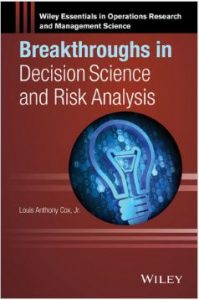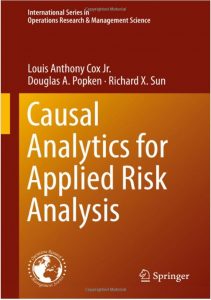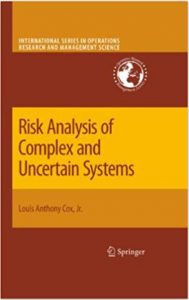Our proprietary AI technology is designed and continuously developed based on multiple decades of rigorous research activities. This page features some of our latest and most relevant publications of our research team (*):
Cox LA (2023). Book Review of The Alignment Problem: Machine Learning and Human Values by Brian Christian. Risk Analysis: 43, 423-428.
Cox LA (2023). Re-assessing human mortality risks attributed to PM2.5-mediated effects of agricultural ammonia. Environ Res. 2023 Apr 15;223:115311. doi: 10.1016/j.envres.2023.115311. Epub 2023 Jan 30. PMID: 36731597.
* * * * *
Ted W. Simon, Cox LA Jr., and Richard A. Becker (2002). Can the Predictive Analytics Toolkit (PAT) handle a genomic data set? Computational Toxicology, Vol 24, 100241.
Cox LA (2022). Book Review of Morality: Restoring the Common Good in Divided Times by Jonathan Sacks. Risk Analysis. 42: 653-655.
Campbell J, Clewell H, Cox T, Dourson M, Ethridge S, Forsberg N, Gadagbui B, Hamade A, Naidu R, Pechacek N, Peixe TS, Prueitt R, Rachamalla M, Rhomberg L, Smith J, Verma N. (2022) The Conundrum of the PFOA human half-life: An international collaboration. Regul Toxicol Pharmacol, May 7, 132:185.
* * * * *
Cox LA Jr. (2021) Toward practical causal epidemiology. Global Epidemiology.
Cox LA Jr. (2021) Thinking about Causation: A Thought Experiment with Dominos. Global Epidemiology.
Cox LA Jr. (2021) Information Structures for Causally Explainable Decisions. Entropy.
Michael Greenberg and Cox LA Jr. (2021) Plutonium Disposition: Using and Explaining Complex Risk‐Related Methods. Risk Analysis.
Cox LA Jr., Hans B. Ketelslegers and R. Jeffrey Lewis (2021) The shape of low-concentration dose–response functions for benzene: implications for human health risk assessment. Critical Reviews in Toxicology.
Julie E. Goodman, Wenchao Li and Cox LA Jr. (2021) Commentary: Using potential outcomes causal methods to assess whether reductions in PM2.5 result in decreased mortality. Global Epidemiology.
Cox LA Jr. (2021) Teaching Data Analytics More Effectively: Book Review of The Art of Statistics: How to Learn from Data by David Spiegelhalter ( Basic Books, New York, NY, 2019). Risk Analysis.
* * * * *
Cox LA Jr. (2020) Answerable and unanswerable questions in risk analysis with open-world novelty. Risk Analysis.
Cox LA Jt (2020) Higher line speed in young chicken slaughter establishments does not predict increased Salmonella contamination risks. Poultry Science.
Greenberg MR, Cox A, Bier V, Lambert J, Lowrie K, North W, Siegrist M, Wu F. (2020) Risk analysis: Celebrating the accomplishments and embracing ongoing challenges. Risk Analysis.
Cox LA Jr, Popken DA. (2020) Should air pollution health effects assumptions be tested? Fine particulate matter and COVID-19 mortality as an example. Global Epidemiology 2020 Sep 2:100033. doi: 10.1016/j.gloepi.2020.100033. https://pubmed.ncbi.nlm.nih.gov/32905083/
Cox L.A. Jr. (2020) Ambiguous associations of air pollution with mortality in Massachusetts. Letter to the Editor. American Journal of Epidemiology. September, 2020 https://doi.org/10.1093/aje/kwaa186
Cox LA Jr. (2020) Using Bayesian networks to clarify interpretation of exposure-response regression coefficients: blood lead-mortality association as an example. Critical Reviews in Toxicology 2020 Sep 9:1-12. doi: 10.1080/10408444.2020.1787329. https://pubmed.ncbi.nlm.nih.gov/32903110/
Cox LA Jr. (2020). Thinking better: Six recent books on natural, artificial, and social intelligence. Risk Analysis. 40(6):1302-19.
Cox LA Jr. (2020) Implications of nonlinearity, confounding, and interactions for estimating exposure concentration-response functions in quantitative risk analysis. Environmental Research;187:109638.
Cox LA Jr, Goodman JE, Engel AM. (2020) Chronic inflammation, adverse outcome pathways, and risk assessment: A diagrammatic exposition. Regul Toxicol Pharmacol.; 114:104663. doi:10.1016/j.yrtph.2020.104663
Cox LA Jr. (2020) Target Sites: Cardiovascular. Chapter 51 in P. Wexler et al. (Eds.) Information Resources in Toxicology: 5th Edition. Elsevier. Academic Press.
Cox LA Jr. (2020) Target Sites: Hematopoietic. Chapter 54 in P. Wexler et al. (Eds.) Information Resources in Toxicology: 5th Edition. Elsevier. Academic Press.
Cox LA Jr, Popken DA, Sun J, Liao XP, Fang LX. (2020) Quantifying human health risks from virginiamycin use in food animals in China. Risk Analysis. 40(6); 1244-1257. 10.1111/risa.13466. doi:10.1111/risa.13466
Maldonado G, Cox LA Jr. (2020). Causal reasoning in epidemiology: Philosophy and logic. Global Epidemiology. https://doi.org/ 10.1016/j.gloepi.2020.100020
Cox LA, Jr. (2020) Nonlinear dose-time-response functions and health-protective exposure limits for inflammation-mediated diseases. Environmental Research 182, March 2020. https://doi.org/10.1016/j.envres.2019.109026
Cox LA, Jr. (2020) Dose-response modeling of NLRP3 inflammasome-mediated diseases: Asbestos, lung cancer, and malignant mesothelioma as examples. Critical Reviews in Toxicology. 2020 Jan 6:1-22. doi: 10.1080/10408444.2019.1692779.
Cox LA, Jr. (2020). Book Review of On Grand Strategy. Risk Analysis 40(20): 435-438.
* * * * *
Cox T. (2019) Learning causal graph models from data. Wiley StatsRef: Statistics Reference Online. DOI: 10.1002/9781118445112. stat08149
Cox LA. (2019) Causal prediction and forecasting. Wiley StatsRef: Statistics Reference Online. DOI: 10.1002/9781118445112. stat08147
Cox LA. (2019) Causal graph models for predictive and prescriptive analytics. Wiley StatsRef: Statistics Reference Online. DOI: 10.1002/9781118445112. stat08146
Cox LA Jr. Modernizing the Bradford Hill criteria for assessing causal relationships in observational data. Critical Reviews in Toxicology. 2018 Nov 15:1-31. doi: 10.1080/10408444.2018. 1518404.
Cox LA Jr. Improving causal inference in risk analysis. Risk Analysis. 2013 Oct; 33(10): 1762-71.
(*) A complete profile of publications can be found from Google Scholar



DESCRIPTION
Discover recent powerful advances in the theory, methods, and applications of decision and risk analysis
Focusing on modern advances and innovations in the field of decision analysis (DA), Breakthroughs in Decision Science and Risk Analysis presents theories and methods for making, improving, and learning from significant practical decisions. The book explains these new methods and important applications in an accessible and stimulating style for readers from multiple backgrounds, including psychology, economics, statistics, engineering, risk analysis, operations research, and management science.
Highlighting topics not conventionally found in DA textbooks, the book illustrates genuine advances in practical decision science, including developments and trends that depart from, or break with, the standard axiomatic DA paradigm in fundamental and useful ways. The book features methods for coping with realistic decision-making challenges such as online adaptive learning algorithms, innovations in robust decision-making, and the use of a variety of models to explain available data and recommend actions. In addition, the book illustrates how these techniques can be applied to dramatically improve risk management decisions. Breakthroughs in Decision Science and Risk Analysis also includes:
- An emphasis on new approaches rather than only classical and traditional ideas
- Discussions of how decision and risk analysis can be applied to improve high-stakes policy and management decisions
- Coverage of the potential value and realism of decision science within applications in financial, health, safety, environmental, business, engineering, and security risk management
- Innovative methods for deciding what actions to take when decision problems are not completely known or described or when useful probabilities cannot be specified
- Recent breakthroughs in the psychology and brain science of risky decisions, mathematical foundations and techniques, and integration with learning and pattern recognition methods from computational intelligence
Breakthroughs in Decision Science and Risk Analysis is an ideal reference for researchers, consultants, and practitioners in the fields of decision science, operations research, business, management science, engineering, statistics, and mathematics. The book is also an appropriate guide for managers, analysts, and decision and policy makers in the areas of finance, health and safety, environment, business, engineering, and security risk management.
DESCRIPTION
- Highlights causal analytics methods that answer how changing decision variables can change probabilities of various outcomes
- Presents models, algorithms, principles, and software for deriving causal models from data in order to optimize decisions
- Surveys modern analytics methods useful for decision, risk, and policy analysis
Mega‐Review: Causality Books (2019) – Causal Analytics for Applied Risk Analysis by Louis Anthony Cox, Douglas A. Popken, and Richard X. Sun. Springer, International Series in Operations Research & Management Science; The Book of Why: The New Science of Cause and Effect by Judea Pearl and Dana Mackenzie. New York: Basic Books; and Causality: Models, Reasoning and Inference by Judea Pearl, Cambridge, UK: Cambridge University Press. RA Journal.
DESCRIPTION
- Shows practitioners how Quantitative Risk Analysis can improve risk management decisions and policies
- Demonstrates applications in complex and uncertain biological, engineering, and social systems
